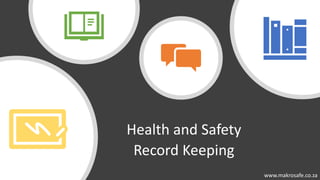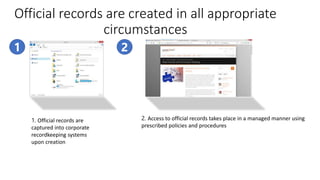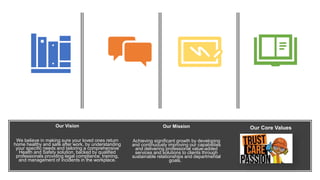Health and Safety record keeping system
- 1. Health and Safety Record Keeping www.makrosafe.co.za
- 2. Policies must be in place for record management Below are some guidelines on good record keeping and storage practices. Retrieval of records • Control of records placed in archives and the archives annex remains with the office of origin. Retrieval of records from the archives and the archives annex is coordinated by the individual offices and the archives. Destruction of records • This policy is applicable for all records not of enduring value. No record will be destroyed without the written permission of the office involved. • Confidential records must be shredded, burned or otherwise physically destroyed as to leave their content unreconstructed. Determination of what constitutes confidential records is the responsibility of the division. • At least once a year, each office will review its records retention and disposition schedules and determine which records have become obsolete. • It is the responsibility of the individual office to destroy its obsolete records. • The office is responsible for destruction whether the records are stored in archives or remain on site. For records destroyed on site, a departmental representative will make a destruction report for the records officer.
- 3. Official records are created in all appropriate circumstances 1. Official records are captured into corporate recordkeeping systems upon creation 2. Access to official records takes place in a managed manner using prescribed policies and procedures 1 2
- 4. 3. Official records can be found upon demand 4. Records management shall be managed and planned in a strategic and corporate manner 5. All staff shall receive training on records management as outlined in the organisation’s. 6. Organisations shall implement reporting mechanisms and progress in order to keep senior management informed about records management. 7. The organisation shall develop and implement records management policies and practices. 8. The employer will ensure compliance audits take place on a regular basis within agreed intervals of time, and the results of the audits and reviews will be documented and forwarded to the Department of Labour. 9. The employer will afford the inspector full cooperation throughout this process. 10. Employers are responsible for ensuring that sufficient evidence is immediately available for the inspector to complete the review. Failure to provide such evidence will require the Department of Labour to undertake the necessary analysis of the employer’s recordkeeping systems and practices at the organisation’s cost.” 3 Official records . . . Continued
- 5. Framework and Safety Risk Assessment Form and Policies The framework is described below: • Health and Safety Policy Statements: General statement and policy examples, including contractors. • Standard Health and Safety and Risk Assessment Forms: Annual audit, risk assessment forms & plans. • Environmental forms: Policy, assessment checklist & action plan and waste disposal note. • First Aid, Accidents and Disease. Accident, investigation, treatment and report forms. • Fire Safety. Risk Assessment forms, policy and procedures and records. • Smoke free, drugs and alcohol-free policy. Up-to-date policies governing smoking,drugs and alcohol. • Safe driving. Safe Driving Policy, Guidance for Employees who drive for work and vehicle checklist. • Display screen equipment. Questionnaire, identification & eyesight records and risk assessment. • Chemical and hazardous substances. Safety data, risk assessment and action plan forms. • Personal Protective Equipment. Risk survey and acknowledgement of use. • Manual handling. Assessment checklist & control forms, employee assessments and action plan. • Equipment and Machinery. Maintenance records, and risk assessment forms. • Hot work. Risk assessment, action plan and permit forms. • Asbestos containing materials. Inspection, assessment action plan, register, controls and disposal forms.
- 6. Objectives The objectives of this form are: • Review of Health and Safety system, identification of areas of low/noncompliance. • Identification of employee training needs to create a safer working environment. • Assessment of key hazards within the workplace, which will require a Risk Assessment • Effectiveness of existing audits and management controls. • Recommendation for improvement actions for senior management team.
- 7. Single Hazard Risk Assessment Form • This form contains the following sections: - • Description/Identification of the hazard/risk • Consequences - description of the harm that might be caused by the hazard/risk • Identification of the persons at risk, and the level of risk • Consideration of precautions and controls • Record of the form's inclusion in the relevant Risk Assessment Action Plan Every Quarter
- 8. Our Vision We believe in making sure your loved ones return home healthy and safe after work, by understanding your specific needs and tailoring a comprehensive Health and Safety solution, backed by qualified professionals providing legal compliance, training, and management of incidents in the workplace. Our Mission Achieving significant growth by developing and continuously improving our capabilities and delivering professional value-added services and solutions to clients through sustainable relationships and departmental goals. Our Core Values
Editor's Notes
- Once you find your sources, you will want to evaluate your sources using the following questions: Author: Who is the author? Why should I believe what he or she has to say on the topic? Is the author seen as an expert on the topic? How do you know? Current: How current is the information in the source? When was the source published? Is the information out-of-date? Accuracy: Is the content accurate? Is the information presented objectively? Do they share the pros and cons?
- Now, that you have narrowed your topic, you will want to organize your research in a structure that works. There are some common organizational patterns based on the kind of research you are doing. Organizational Structures: Cause and Effect- this kind of structure is great for explaining the causes and effects of a topic Compare and Contrast- in this pattern you highlight the similarities and differences of the topic Explain process- this structure is great for outlining a series of steps to follow; Definition- if you want to make sure your audience understands what something is using illustrations, meanings, clarifying misconceptions, you may want to use this structure Classification- a common organizational structure is grouping like topics or facts from the research together. For instance, in the internet safety about social media apps, you may organize the research where you look at each social media app one at a time
- You can use this slide as your opening or closing slide. Should you choose to use it as a closing, make sure you review the main points of your presentation. One creative way to do that is by adding animations to the various graphics on a slide. This slide has 4 different graphics, and, when you view the slideshow, you will see that you can click to reveal the next graphic. Similarly, as you review the main topics in your presentation, you may want each point to show up when you are addressing that topic. Add animation to images and graphics: Select your image or graphic. Click on the Animations tab. Choose from the options. The animation for this slide is “Split”. The drop-down menu in the Animation section gives even more animations you can use. If you have multiple graphics or images, you will see a number appear next to it that notes the order of the animations. Note: You will want to choose the animations carefully. You do not want to make your audience dizzy from your presentation.







